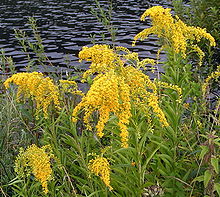(from Wikipedia)
Food:
"Goldenrod plants have been cooked like spinach or added to soups, stews and casseroles. Flavor and texture varies with species, age and habitat. Dried goldenrod leaves or flowers have been used to make pleasant teas (Mormon tea, Blue Mountain tea), usually sweetened with honey. The flowers are edible and provide and attractive garnish for salads. The seeds can be gathered for survival food and used to thicken stews and gravies." (Kershaw 184)
"Recipe 1: Goldenrod Leaf Gallo Pinto
Rice and beans is a household staple. I love having a well-spiced bowl full ready and waiting at meal or snack time. Cooking up a big pot has been a periodic Sunday-evening tradition ever since my husband and I visited Nicaragua, where a version of this dish is a national favorite. I can never get mine to taste quite as good, but here's my version.
Begin preparing this dish one day in advance by soaking 1 cup pinto beans in water. Place beans in a large bowl. Fill with room-temperature water, and cover with a dark cloth. Change the water twice throughout the day and once more right before you go to bed. Do this by straining the water out, rinsing the beans well until they do not foam, and then refilling the bowl with water.
Cook, 1 to 2 cups white or brown rice in a rice cooker.
Bring a large pot of water to a boil; reduce to a low simmer. Meanwhile drain and rinse the beans. Add beans to simmering water. Keep a close eye on the beans, making sure they never come to a rolling boil. Maintain a slow simmer. This prevents the skin from cracking and the beans from becoming waterlogged. Cook, stirring occasionally, for about 1 hour, or until beans are soft. Drain, but retain the cooking water.
In a blender combine about one-fourth of the cooked beans and 2/3 cup of the cooking liquid. Blend on high until the mixture is just liquefied. Some remaining chunks are fine; they will add a nice texture to the dish.
In a large pot heat 2 tablespoons organic vegetable oil to medium. Add 1 jalapeno, 1 onion, and 5 cloves garlic, all chopped. Saute until tender, about 8 minutes. Add the blended bean mixture and 1 cup roughly chopped goldenrod leaves. Stir well. Bring to a simmer, and cook until leaves are tender, about 4 minutes. Add the beans and rice. Stir gently to combine. Add salt and pepper to taste. Cook for 10 more minutes to combine flavors. Serve immediately, or store in fridge for up to one week. Delicious hot or at room temperature."
Recipe 2: Goldenrod Seed Chicken Soup
Make a good homemade chicken soup by simmering a whole farm-fresh chicken with carrots, celery, garlic, onion, bay leaves, and salt and pepper for about 6 hours, or until the broth is reduced and delicious. Strain the old vegetables, meat, and bones out of the broth.
Put broth back into soup pot. Add goldenrod seeds to thicken soup. Add fresh carrots and celery, and simmer. Pick meat from bones, and add to simmering soup. Serve hot with rice, bread, or a hot potato. Garnish with chopped fresh parsley or fresh thyme." (Morgan 53-4)
Medicine:
"Goldenrod tea has been used for many years to relieve intestinal gas and cramps, colic and weakness of the bowels and bladder. It is said to reduce the production of mucous in the bronchi, and animal and test tube studies have shown that goldenrod extracts increase the production of urine. Usually goldenrod has been recommended as a cold and flu remedy and as a kidney tonic. Canada goldenrod contains the compound quercetin, which has been used to treat hemorrhagic nephritis (inflammation and bleeding of the kidneys). The tea was also used as a wash for treating rheumatism, neuralgia (pain along a nerve) and headaches, or it was mixed with grease and applied as a salve to sore throats. The flowers were also chewed to relieve sore throats. Powdered leaves and flowers were sprinkled on wounds to stop bleeding, and boiled plants provided antiseptic poultices and lotions. The roots were used for treating burns and relieving toothaches and were also made into medicinal teas for treating colds kidney stones and painful ulcers. Compounds in goldenrod are believed to stimulate the immune system, so these plants might be used to strengthen allergy defenses at the beginning of hayfever season (like a vaccine). Some herbalists recommend goldenrod tea for relieving exhaustion and fatigue, while others report that it has hypoglycemic activity and is of great benefit to diabetics." (Kershaw 184)
Other Uses:
"Goldenrod flowers produce a yellow dye with alum as a mordant and a gold dye with chrome as a mordant." (Kershaw 185)
"The Spanish New Mexicans mash the fresh plant, mix it with soap, and bind it into a sore throat, and the Zuni Indians chew it for the same purpose." (Curtin 111)
Internet Resources
